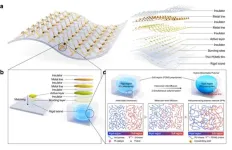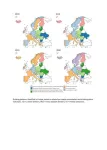(Press-News.org) □ Professor Kyung-In Jang’s research team from the Department of Robotics and Mechatronics Engineering at DGIST (President Kunwoo Lee) has succeeded in developing a highly stable stretchable electronic device, which overcomes the mechanical limitations of conventional inorganic materials and enhances their stretchability and durability. In collaboration with Professor Taeho Park’s team from the Department of Chemical Engineering at POSTECH (President Seong-Keun Kim), the research team has developed a stretchable hybrid polymer and applied it to electronic devices, enabling them to operate stably even under deformation or external impacts. This technology is expected to be used in various industries, such as displays, healthcare, and wearables.
□ The “stretchable electronic device” technology is a promising technology applicable to various industries, such as displays, wearables, and healthcare. However, when subjected to deformation, such as stretching and bending, or external impacts, maintaining stable electrical functionality in these components becomes challenging. To address this issue, various research efforts are underway. Against this backdrop, the DGIST-POSTECH joint research team has developed a “stretchable hybrid polymer” and introduced a new strain isolation strategy to integrate [1]stretchable inorganic electronic devices with high efficiency, creating a new “stretchable electronic device” that operates stably even under deformation or external impacts.
□ First, the research team developed the “stretchable hybrid polymer” through “Interpenetrating Polymer Network (IPN) cross-linking.” The IPN is a 3D polymer structure formed by physically and chemically cross-linking two or more polymers, maintaining each polymer’s features while reinforcing each other. It can maintain high stability and performance even under deformation by inducing physical entanglement between polymers, which forms an excellent mechanical interface. The research team created a “stretchable hybrid polymer” using silicone-based polymers with different elastic moduli, polydimethylsiloxane (PDMS) and polyurethane (PU).
Subsequently, the team built a substrate with the developed stretchable polymer and combined it with the high-efficiency stretchable electronic component made from inorganic materials to complete the “stretchable electronic device.” The newly created electronic device is designed to distribute strain that occurs at a single point when subjected to stretching or bending, thus reducing mechanical strain on the device and maintaining its high stability. This significantly reduces physical damage and performance degradation that can occur in existing stretchable electronics.
Professor Kyung-In Jang from the Department of Robotics and Mechatronics Engineering said “We are pleased to have developed the stretchable electronic device system that maintains the performance of inorganic materials, which are mechanically vulnerable, even under various deformations and physical damages.” He also added, “We confirmed the system’s stability in applications such as stretchable micro-light emitting devices and heaters through verification, and we will further enhance this research to apply it in various industries such as healthcare and wearables as well as stretchable displays.”
The results of this research have been published online in ACS Nano, the renowned international journal in the field of nanoscience.
- Corresponding Author E-mail Address : finns0220@dgist.ac.kr
[1] Stretching: The phenomenon where an object elongates when a force acts outward parallel to its central axis.
2 IPN, Interpenetrating Polymer Network: A polymer composite in which two or more polymers are physically mixed and interpenetrate each other but do not chemically bond with each other.
3 PDMS: An abbreviation for polydimethylsiloxane, a type of silicone elastomer.
END
DGIST-POSTECH joint research team developed next-generation impact-resistant stretchable electronic component
2024-06-25
ELSE PRESS RELEASES FROM THIS DATE:
Robots help put brakes on inflammatory diseases
2024-06-25
Fully automated diagnostic techniques, including liquid handling robots, are poised to improve the lives of millions of people living with inflammatory diseases worldwide.
A landmark WEHI study has revealed new methods in detecting necroptosis, a key factor in many inflammatory diseases like psoriasis, arthritis and inflammatory bowel disease.
The findings mark a huge leap forward in our ability to diagnose necroptosis accurately. They also offer practical methods that can be easily reproduced in hospitals worldwide, giving hope for new ways to treat inflammatory diseases.
At a glance
Necroptosis is a form of cell death, one of the body’s natural ...
Chronic loneliness may increase stroke risk among older adults
2024-06-25
Embargoed for release: Monday, June 24, 7:30 PM ET
Key points:
In a study of loneliness and stroke risk over time among adults ages 50+, those who experienced chronic loneliness had a 56% higher risk of stroke than those who consistently reported not being lonely.
Those who experienced situational loneliness did not have an elevated risk of stroke—suggesting that the impact of loneliness on stroke risk occurs over the longer term.
Boston, MA—Chronic loneliness may significantly raise older adults’ risk of stroke, according to a new study led by Harvard T.H. Chan School of Public Health.
“Loneliness is increasingly considered a ...
Risk of Parkinson’s more than double for people with anxiety
2024-06-25
The risk of developing Parkinson’s is at least twice as high in people with anxiety compared to those without, finds a new study by UCL researchers.
The research, published in the British Journal of General Practice, investigated whether there was a link between people over the age of 50 who had recently developed anxiety and a later diagnosis of Parkinson’s.
The team used UK primary care data between 2008 and 2018 and assessed 109,435 patients who had developed anxiety after the age of 50 and compared them to 878,256 matched ...
European countries differ in their drinking styles – what is yours?
2024-06-25
A new study of drinking patterns across Europe from 2000 to 2019 shows that drinking occurs in stable, beverage-specific clusters that seem to be partly determined by geography. The study was published today by the scientific journal Addiction.
The study identified six drinking patterns in Europe in 2019:
Wine-drinking countries: France, Greece, Italy, Portugal, and Sweden. Characterized by the highest consumption of wine, lowest consumption of beer and spirits, and lowest overall alcohol consumption.
High beer/low spirit drinking ...
Children born underweight are at increased risk of disease if they develop obesity
2024-06-25
Scientists at the University of Copenhagen discover a link between birthweight and the risk of health complications from obesity during childhood. The findings highlight the need for prevention and treatment approaches for children with obesity who were born with a lower birth weight.
Hundreds of millions of people live with obesity, which is normally measured as a higher-than-optimal body mass index (BMI). While an elevated BMI increases the risk of a range of cardiometabolic diseases and is responsible for around five million deaths a year according to the World Health Organization, not everyone is equally at risk.
Scientists at the ...
New research questions safety of cannabidiol for pregnant women
2024-06-25
Vienna, Austria: Cannabidiol (CBD), one of the active ingredients in cannabis, is thought to be safe as it does not cause a “high”. Increasing numbers of pregnant women take CBD, believing that it can help alleviate symptoms such as morning sickness, insomnia, anxiety and pain.
However, research presented today (Tuesday) at the Federation of European Neuroscience Societies (FENS) Forum 2024 [1,2], suggests that it may affect offspring. Two studies in mice have shown that gestational exposure to CBD alters the behaviour of offspring and also affects the nerve cells (neurons) in the insular cortex (IC) ...
Scientists can now detect antibiotics in your fingerprints – aiding the fight against drug-resistant TB
2024-06-25
A fingerprint may soon be all a doctor needs to check whether tuberculosis patients are taking their antibiotics – thanks to a new study led by the University of Surrey.
Scientists successfully detected the drugs in finger sweat – and with almost the same accuracy as a blood test.
Professor Melanie Bailey, an analytical chemist and co-author of the study from the University of Surrey, said:
“Up until now, blood tests have been the gold standard for detecting drugs in somebody’s ...
Heart disease model puts cells to work
2024-06-25
By Leah Shaffer
Using animals to study heart disease doesn’t always translate well to human health outcomes, and human heart cells available for research don’t work outside the human body.
“You can’t keep them alive, much less function outside of the person for long enough to study these processes,” said Nathaniel Huebsch, an assistant professor of biomedical engineering in the McKelvey School of Engineering at Washington University in St. Louis. Huebsch is studying cells with a mutation that causes hypertrophic cardiomyopathy (HCM), a disease that can set off heart failure ...
Positive emotion skills combat burnout among health care workers
2024-06-24
Intervention improved well-being in workers who were highly stressed by the job
Health care worker burnout was on the rise before COVID-19 and continues today
Addressing significant structural barriers in U.S. health care ‘needs to be a top priority’
Easily accessible individualized solutions also are needed to boost well-being in stressed health-care workers
CHICAGO --- The COVID-19 pandemic exacerbated already rising rates of burnout among American health care workers. A new Northwestern University study found learning and practicing skills that increase positive emotion like gratitude, mindful awareness and self-compassion ...
Partridge receives Department of Energy Vehicle Technologies Office Lifetime Distinguished Achievement Award
2024-06-24
Bill Partridge, a recently retired distinguished researcher at the U.S. Department of Energy’s Oak Ridge National Laboratory, was recognized by DOE’s Vehicle Technologies Office, or VTO, for leading world-class research in transportation throughout his 25-year career. His expertise has guided the development of advanced diagnostic tools that enabled next-generation engines and emissions control systems.
Partridge was presented the Lifetime Distinguished Achievement Award during the VTO Annual Merit Review held on June 3, 2024, in Washington, D.C. He was nominated for the award by the VTO Decarbonization of Offroad, Rail, Marine ...




